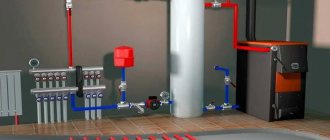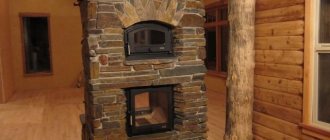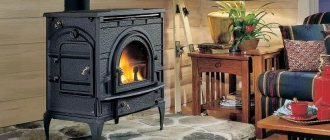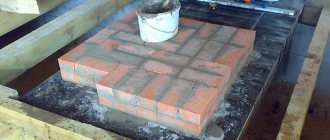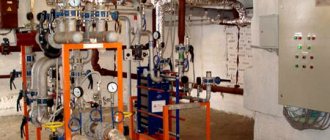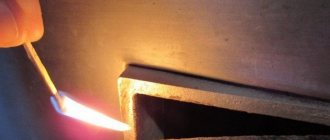Converting a brick or metal stove to gas processing is a difficult process that requires a serious analysis of all components. It is imperative to find out which types of gas burners are ideal for furnaces and which ones should not be installed. After all, the result must meet exactly your requirements.
It would seem that the choice of model can be entrusted to gas workers; they can also be entrusted with reworking the burner block and installing the burner itself. But where is the guarantee that the equipment that you will be offered to install will have the necessary operating parameters and desired functionality?
In this article we will tell you how to independently understand the types of gas burners, the basic rules for their installation and operation, so that you can consciously choose which device to install in your heating stove.
Pros and cons of using a burner for heating
A gas burner is a device that, by mixing air with natural or liquefied gas and supplying the mixture to the outlet, forms a torch and distributes the flame. It ensures efficient combustion of fuel and regulation of the combustion process.
Advantages of using gas burners for heating stoves:
- Ease of use. Gas burners greatly simplify the process of heating furnaces, eliminating the need to prepare solid fuel and constantly maintain combustion.
- Controllability of the heating process. Simple models, without automation, need to be turned off independently as soon as the temperature reaches the required level, leaving only the wick lit. Burners with a control panel make life much easier by more accurately setting the temperature.
- Security. Automatic nozzles have overheating protection functions and turn off the gas supply in case of poor draft or lack of flame.
- Minimal contamination of the chimney duct. A scheduled inspection of the chimney is carried out once a year, mainly for prevention - little soot is formed from the combustion of gases.
The transition from solid fuel equipment to heating with gas burners greatly simplifies life, freeing up a lot of time for more interesting and useful activities.
Gas burners are intended for heating private houses, baths, industrial buildings - the purpose must be taken into account when choosing the type of equipment
The main disadvantage of converting a stove by installing a gas block is that the energy efficiency is not very high. High fuel consumption is especially noticeable if the gas heating system in a country house is designed by an amateur.
In addition, it is not always possible to obtain permission to install a gas burner - if the stove is outdated, the chimney is of incorrect design, or the room parameters do not meet fire safety standards.
Equipment setup
Floor-standing gas boilers with an atmospheric burner can be configured independently. Pressurized systems are regulated by an automatic control unit and do not require additional configuration.
Scheme of actions for setting up single-stage equipment:
- Install the device on the boiler.
- Connect to the gas pipe.
- Check for absolute tightness.
- Remove the burner housing.
- Using a pressure gauge, measure the gas pressure at the inlet.
- Connect to electricity. Make sure that the jumpers and phases are connected correctly.
- Place a gas analyzer in the chimney pipe.
- Start the device.
- Using a pressure gauge, take pressure readings at the outlet of the burner block. Pressure readings must correspond to the parameters indicated in the data sheet.
- Adjust the air flow using the air damper.
- The gas analyzer readings must also comply with all gas equipment installation standards.
Setting up gas equipment should be carried out by specialists. The simplest open-type boilers can be configured independently if you have certain skills and knowledge of the design of the burner unit. The efficiency of the boiler, its level of efficiency, and fuel consumption depend on the quality of the burner. It is possible to superficially determine that the equipment is malfunctioning by the changed burner flame.
A heating system where the main element is a gas stove is a common type of heating for private households and cottages. There are many things in favor of natural gas as a heat source: high efficiency, environmental friendliness, and the ability to make the heating process fully automated. The fuel itself is also the most inexpensive at present, unless, of course, you take into account wind energy and solar radiation. But these methods have not yet found wide demand due to the unaffordable price of the equipment.
The quality of gas heating depends on how efficiently the gas burner for the stove works.
Selecting a gas burner: types and characteristics
The main elements of a gas burner are a mixer and a burner nozzle with a device that stabilizes the flame. Depending on the purpose, the models differ in design.
To make the most of gas injectors, you need to install equipment with automation. You can also choose a device that can operate not only on gas, but also on diesel fuel and fuel oil
When choosing a gas burner for installation in a furnace, pay attention to the following characteristics:
- coefficient of performance (efficiency);
- heating device power;
- energy efficiency;
- flame length;
- safety;
- optionality.
The operating parameters of the gas burner must take into account the chemical composition of the fuel, the purpose and characteristics of the room, the conditions of use - a house or a bathhouse, an industrial stove or a homemade wood-burning stove, for constant or periodic heating, etc. The technical data sheet for the burner indicates the scope of application of the device.
Types of stove gas burners for home or bathhouse
The design and operating principle of gas burners for household heating stoves should be studied more carefully, separately considering the two main types of equipment - atmospheric and forced-air options. They are distinguished by the method and speed of mixing gas with air.
Atmospheric gas burners
The design of the atmospheric burner is simple and consists of one or more hollow tubes into which gas is supplied under pressure. The gas, mixing with air coming directly from the room, forms a fuel-air mixture and is ignited using piezo ignition or electric lighters.
The design of an atmospheric burner using the example of an AGG gas burner device designed to operate on natural gas and be installed in sauna stoves
For normal operation of an atmospheric gas burner, it is necessary to ensure good draft and an effective ventilation system. The main disadvantage of the device is that any change in air movement leads to changes in the proportion of the gas-air mixture, and therefore to an uneven combustion process.
Air enters the atmospheric burner under the influence of natural draft. Final mixing occurs in the combustion chamber, where the gas gradually burns
If there is a lack of oxygen, the burner does not completely burn the gas, which leads to the release of a significant part of the unused fuel into the atmosphere through the chimney duct serving the heating unit.
An example of technical characteristics of atmospheric gas burners UGOP 12, 16, 30. Pay attention to the main parameters: thermal power, nominal gas pressure, shutdown time in case of ignition burner extinguishing or lack of draft, size of the gas supply fitting
Pressurized gas burners
Pressurized gas burners, or, as they are also called, blower, fan, air blower, are devices where gas is mixed with air using a fan, the gas-air mixture enters a closed chamber and burns there.
The operation of the nozzles of a gas burner installed in a closed combustion chamber depends little on the state of the atmosphere in the room. The air supply intensity is adjusted by changing the fan rotation speed.
Blast gas burners can be adjusted to any power, and also use liquefied gas as fuel
High-quality air supply and mixing with gas ensures more complete combustion of fuel. Pressurized burners are on average two times more efficient than atmospheric type equipment - their efficiency is 95-98%. The equipment operates stably even at low gas pressure and does not require the installation of a bulky chimney.
Instead of a standard chimney system, a coaxial chimney works in tandem with a blower burner, which can be led outside through the wall located next to the stove.
Air for the operation of forced-air burners is pumped using a fan, which also creates the necessary pressure and regulates the flame pressure
The main disadvantage of the device is its dependence on the energy source, high noise level, and higher price than atmospheric burners. But short-flame models of fan gas burners can be installed in wood-burning stoves. The main condition for use, in this case, is that the flame should not rest against the walls of the firebox.
In fact, there are many more ways to supply air and gas to burners. There is no need to study everything for installation in a home oven, since only a few of them are used in the production of small household appliances.
a — diffusion burner b — injection burner with central gas supply, single-flare; c — injection multi-flare; g - injection, with central gas supply, multi-nozzle; d - the same, but flat-flare; e - injection with peripheral fuel supply; g - with air supply, central gas supply and axial swirler; h - the same, with a snail air supply and peripheral fuel supply; and - the same, with tangential air supply
Having decided on the type of gas burner, you can continue to study the features of individual models and their functionality.
Differences in the way power is controlled
The ability to adjust the thermal power of the burner plays an important role when organizing the process of heating a room. This is especially true for those houses where permanent residence is planned.
From a controllability point of view, gas stove burners can be divided into two categories:
- Single stage. Gas is supplied to the injector without the ability to influence power. If the device is automated, then when a certain temperature level is reached, the burner will turn off and then turn on again when the room becomes cooler.
- Two-stage. Two combustion modes, normal and economical, are automatically adjusted and allow you to maintain a more or less stable temperature in the room. Fewer turns on and off reduces wear on parts and extends the service life of the device.
Two-stage devices are divided into floating or modulated models. The power can vary from 10 to 100% or more, and accurately set a comfortable temperature in the house. The gas burner device can be automatic, mechanical or pneumatic.
The ability to regulate thermal power allows you not only to set the optimal temperature regime, but also to save energy. For example, fuel savings when using a modulated gas burner reaches 15-20%.
Additional design options
In order not to use lighters or wicks to ignite the stove, the design of the gas burner provides two methods of ignition:
- electric ignition - requires connection to the electrical network;
- piezo ignition - used in simpler burner models and does not require power.
Installing special sensors that monitor oxygen levels makes it possible to detect flame extinction and turn off the fuel supply. This function protects against gas leaks and emergency situations.
Some equipment models require working not only with natural and liquefied gas, but also with diesel fuel. When choosing such models, pay attention to how easy and quickly this transition is made.
Trouble-shooting
Having a boiler at home brings many advantages, but it also has a number of disadvantages, and the user does not always know what to do correctly. Boiler faults are common to many types. It is important to promptly determine the cause of these faults before calling emergency services. List of the most common and most likely faults.
First of all, if the boiler does not start, you need to check the circuit components:
- network voltage;
- faulty boiler fan switch or motor;
- damaged boiler cables;
- false triggering contacts of automation or commissioning equipment;
- availability of water, whether the gas boiler is powered to the minimum required level specified by the equipment manufacturer.
If the boiler failure is not caused by any of these problems, the following procedure:
Pay attention to the noises made by the boiler, because they are often the first witnesses of destruction. They can also be due to hot water trapped inside the firebox or due to the presence of air in the heating system due to clogged air ducts.- Pipe rupture. It usually occurs due to problems with a jammed boiler feed valve, various scale-forming deposits in the boiler, or a malfunction of the condensate drainage systems.
- Failures due to exceeding the pressure and temperature readings, their corresponding sensors can trigger, for example, due to a broken thermometer or, conversely, which is especially dangerous as a result of real overheating of the boiler.
- The heating circuits are not working, possibly due to poor quality of feed water and scale formation in the boiler pipes.
- A problem occurs with the burner (flame breaks, gas accumulation causes detonation and explosion).
Safety rules when using burners
Failure to comply with precautions when installing and using gas burners for heating premises can lead to emergency situations and accidents: fire in the house, carbon monoxide poisoning.
When operating gas equipment, you should adhere to the following rules:
- Observe the service life. The burner's service life, depending on the model, can range from 8 to 15 years. Then it must be replaced.
- Use models with a function that automatically turns off the device in the absence of draft or flame.
- A stove equipped with gas burner units must meet safety requirements.
The design, installation or repair of a gas burner must be carried out by certified gas service workers, with whom an agreement has been concluded for the supply of fuel and maintenance of the units.
If possible, it is still necessary to use gas boilers or special furnaces that are designed to work with natural or liquefied gas
To obtain permission to install and connect to the main gas network, a number of conditions must be met:
- compliance with the rules for connecting a gas burner;
- appropriate design of the smoke channel, its high-quality insulation;
- installing a spark arrester at the top of the chimney.
This is the minimum requirement for installing forced-air gas burners.
For atmospheric there are additional requirements:
- presence of adjustable traction;
- ensuring good ventilation;
- the volume of the room in which the gas burner is installed is from 12 m3.
If equipment is converted to use liquefied gas, it is necessary to ensure safe storage of the gas cylinder. This can be a separate room or a metal cabinet. If you plan to store gas reserves in a gas tank, then the tank is installed underground at a distance of no closer than 5 m from the building.
Homemade units
There are craftsmen who remake heating systems with their own hands. On the Internet you can even find the necessary diagrams for changing the devices of gas burners, their installation and adjustment.
Typically, metal is used as a material for the manufacture of heating systems. A cast iron firebox would be much more reliable. However, it is not possible to use it at home.
An excellent option for manual work is to order the system from specialists. They will be able to manufacture the device in accordance with all the customer’s wishes. However, the possibility of defects in the boilers cannot be ruled out, which may appear after some time.
Why do you need homemade heating units? The fact is that the marked options have a lower cost. They are made mainly because of the desire to save money. At the same time, these options are inferior to their factory counterparts in efficiency.
Usually only solid fuel and electric units are manufactured. Making a gas or diesel boiler is extremely dangerous. In addition, their installation in the house is strictly prohibited.
According to the principle of operation, a homemade product is no different from a purchased version. It will burn fuel and heat the coolant filled with water.
The main disadvantage of this unit is the lack of warranty. Factory equipment will work and perform its functions. Even if the buyer stumbles upon a defect, he will be able to exchange the product for another.
It is better to use pellets, firewood, and coal as fuel in self-made units. These materials are less dangerous than gas. It is impossible to make heating devices based on the latter.
Simple solid fuel units are the most popular and widespread homemade devices. They are simple, and their design is in many ways similar to a conventional stove. In addition, they are versatile.
Like a conventional stove, these systems can operate on any solid fuel. The main thing is that it burns.
Main parts of a gas boiler.
The efficiency of homemade equipment is significantly lower than factory equipment. It is influenced by many factors.
Among them:
- thermal insulation;
- combustion completeness;
- the correctness of the conclusions.
The efficiency of the unit directly depends on the combustion temperature. The higher it is, the lower the efficiency. In high-quality systems, the temperature in the firebox is maintained at 120–150°C. Higher values reduce the safety of pipes. This in turn significantly reduces the durability of the unit.
When manufacturing heating boilers with a burner, it is better to protect yourself as much as possible from the possible consequences of its operation. Therefore, you should consider a separate purchase of an automatic gas burner, which will be installed in an atmospheric or blown boiler.
You can also make electric heating units with your own hands. Their design may vary. It all depends on the person’s needs. The simplest option is to install a heating element directly into the heating system. In this case, there is no need to make a boiler.
The pipe with the heater must have a sufficiently large diameter. It should be easily removable for repairs and cleaning.
Systems without a heater deserve special attention. Its role is played by water itself. A current is passed through it, and heating occurs due to the movement of water ions. The liquid itself must contain salt.
It is extremely difficult to make such a device. Electric current passes directly through the coolant, so the entire system must be reliably insulated.
One of the dangers of this device is electrical breakdown. Essentially the same as a short circuit. Gas may also accumulate in the system. As a result, heating efficiency will decrease.
From all of the above, the best option is a solid fuel unit. Its body can be assembled from heat-resistant steel. It is characterized by increased strength, less wear and high resistance to thermal influences.
However, heat-resistant steel is expensive and in practice is rarely used in homemade boilers. Another option is cast iron: this material tolerates heat well, although it is difficult to work with. Equipment for the manufacture of cast iron stoves is available only at specialized enterprises.
It is important to understand that without the proper experience and skills, it is better not to make a heating system yourself. Safety must come first
It is enough to make even one inaccuracy, and this can lead to disastrous consequences.
Installation of a gas burner in a heating furnace
We remind you that it is prohibited to install gas equipment yourself. However, it won’t hurt to familiarize yourself with the nuances of installing a gas burner in a stove.
So, installation of a gas burner is permissible in furnaces in which the length, shape, nature and temperature of the flame can be adapted to the nature of the material of the combustion chamber. The flame should not touch the walls, but should be freely located in the combustion space. If it is a brick wall, then the firebox should be made of refractory bricks.
Before installation, check the walls of the stove for cracks, voids, and unsealed seams through which combustion products can enter the room. The room into which the firebox door opens must have an opening window, a ventilation duct and a gap in the door for air to enter from below.
Gas burners of any type are characterized by the creation of high temperatures - more than 1000 °C in the combustion chamber. When installing a gas burner in the oven, you must ensure that the flame does not touch the walls.
The installation process itself is not complicated and is carried out in the following sequence:
- Remove the firebox door.
- A burner is placed in the combustion chamber.
- The shield is secured in the door frame.
- Connect the automation according to the manufacturer's instructions.
At the end of installation, connect the burner to a hose, the other end of which is connected to a gas source.
Installing a burner using the example of an AGG gas burner device: the stage of installing a gas burner block in a furnace with dismantling the ash pan
The system is launched by a master from the gas service, he checks the operation of the nozzles, the automatic control and safety systems, configures and tests the response of the sensors.
Installation of a gas burner in an industrial furnace using the example of an AGG gas burner device. Connecting automation, placing the remote control and thermal cylinder
Another step is to check the tightness of all connections and the presence of traction. After successful startup of the system, the gas installer must issue a completed control certificate for the installation of the burner.
When starting the heating, you should first select the minimum thermal power, heating the stove continuously and little by little or, if there is no power adjustment, cyclically, turning the burner on and off. This is especially important for a brick kiln - strong continuous heating of a cooled brick can lead to cracking.
Single-pipe heating distribution in a private house
This is one of the simplest designs invented for heating a home. Essentially, this is a pipe that comes out of the heating boiler, runs along all the rooms in the house and returns back.
The operation of a single-pipe heating system is based on the simplest physical laws.
The coolant heated in the boiler expands and becomes lighter. Forced out from below by cold and therefore heavy water, the flow tends to occupy the highest point in the heating system.
As the water passes along the heating system, it gives off its heat to the radiators, while cooling. The coolant returns to the boiler already cooled, and the cycle continues again.
Type of circulation, installation and protection
According to the installation scheme in private houses, single-pipe systems differ in:
- vertical - water rises up several risers, from which it enters the heating radiators;
- horizontal - the coolant is supplied to the upper floor through a single riser, then distributed there to all radiators, and only after that it reaches the lower level.
Photo 1. Scheme of a gravity one-pipe heating system with vertical distribution to two wings.
According to the type of circulation, the schemes differ in:
- forced - in order to pump coolant through large systems, special circulation pumps are installed in them;
- gravity - work on the principle of natural circulation of water, rising upward when heated and descending when cooling.
Attention! Natural circulation schemes work successfully only in small houses of up to 100–120 square meters. m. Based on the type of protection against excessive expansion of the coolant, heating circuits can be of two types:
Depending on the type of protection against excessive expansion of the coolant, heating circuits can be of two types:
- open - when the expansion tank is installed at the highest point and is fully or partially exposed to the atmosphere, excess water is drained into the sewer if necessary;
- closed - where a special sealed container is used to receive excess liquid volume, which is mounted in any convenient place.
Advantages and disadvantages
- Due to the fact that the coolant passes through the premises of the house through a single pipe, compared to other schemes, there is a significant saving on materials during construction.
- The interior of the premises suffers less due to the fact that one pipe passes through them instead of two.
- The system contains a smaller volume of water than a two-pipe system, due to this its inertia is reduced and the house warms up faster.
- Easy installation allows you to carry out the work yourself.
As the water passes through the pipes, it cools and the further away the radiator is located, the less heat it receives and the less heat it gets. Therefore, adjusting the temperatures in each room individually in such a scheme is impossible.
Reference! You can achieve the possibility of adjustment in a single-pipe system by using a special wiring - “Leningrad”, which uses bypass lines under each radiator.
When operating without a pressure pump, for high-quality operation of the system, an accelerating manifold is required, which includes an expansion and storage tank at the top point, i.e. in the attic. To eliminate heat loss, it is additionally insulated, which increases the cost of the system.
General rules for installing a chimney for a stove
Another condition for the normal operation of a gas stove is the installation of a chimney. For gas-fired stoves, smoke channels must be vertical, without ledges. The design of the chimney of a wood-burning stove is often not suitable for the removal of gas combustion products.
The slope of the chimney is allowed, but not more than 30°, and provided that the cross-section of pipes on inclined sections is not less than the cross-section of pipes installed vertically
You can refurbish an old chimney by lining it. Upgrade options:
- Installation of a stainless steel pipe in the chimney duct. In this case, the diameter and height of the pipe should be selected according to the characteristics of the chimney duct. The gap between the walls of the chimney and the pipe is filled with non-flammable heat-insulating material such as expanded clay or foam glass.
- Application of FuranFlex technology. The method involves placing an elastic polymer tube inside the channel, which, under pressure, takes its shape and hardens. The protective layer serves to insulate, seal and internally protect the chimney.
If none of the chimney modification options work, you will have to install a new one. Depending on the location of the stove, two options for installing a chimney are possible: an external attached one or an internal one.
The influence of the characteristics of the chimney on the safety of heating is such that it will necessarily be checked by the Fire Inspection authorities with the subsequent issuance of a written certificate, without which the equipment will not be connected to gas networks.
Connection to the gas pipeline
There are two subtleties in connecting to gas pipes: Firstly, a shut-off valve must be installed on the gas pipeline, which will allow you to turn off the gas supply to the burner when it needs to be removed or simply during a long-term heating shutdown (in summer). Secondly, during operation the burner vibrates quite strongly due to the operation of the turbine. Under no circumstances should this vibration be transmitted to the gas pipe, otherwise depressurization may occur. There are two options. You can use a special anti-vibration coupling, or you can connect the burner to the gas pipe using a bellows (corrugated metal) connection. The second option is much more convenient, since the flexible pipe, in addition to its anti-vibration function, will also provide a convenient connection method.
Conclusions and useful video on the topic
Installing an automatic gas burner in a furnace:
General information about the operation of gas burners:
When studying the variety of models and functions of gas burners for furnaces, you need to pay special attention to safety.
Any actions related to design and installation must be coordinated with the gas supply organization, and the installation must be entrusted to an experienced technician. Before purchasing a gas burner, it is also better to consult with gas specialists.
Please share your own experience in converting solid fuel units to gas consumption. It is possible that your recommendations will be very useful to site visitors. Please leave comments in the block form below, post photos related to the topic of the article, and ask questions.
All about gas burners for stoves
Knowing everything about gas burners for stoves is valuable for any consumer. They can be used for heating in the bathhouse and in the house. It is required to understand furnace burners with automation, to calculate their quantity for chamber and other furnaces. The rules for selection, installation and use are also important.
Device
In the vast majority of cases, household gas burners for stoves are designed to be connected to an air heating main. Connection to water circuits is much less common. In some cases, a system is provided that removes heat to adjacent rooms.
Some models of burners for stove heating can also be designed to burn solid or diesel fuel. The standard temperature of the system itself is usually 130 degrees.
A burner device for home or bathhouse consists of:
- valve assembly that regulates the fuel supply;
- steel pipe (usually with a wall thickness of 0.2 cm and a length of up to 10 cm);
- fuel metering cap;
- control knob or button.
Automatic burners are widely used for heating systems in any room. They are much more convenient than designs that do not have automation equipment. Each model is equipped with a strictly defined type of automation. There is virtually no compatibility between these types. Installation of modern burner equipment is very simple and does not require contacting specialists, which is also due to the simplicity of the device.
Principle of operation
Water circuits are rarely connected to gas stoves. The room is heated directly by heated air from the stove. The only difference with a solid fuel stove is that natural gas is used, not wood.
Advice. It is very easy to install a water circuit with a heat exchanger or a water tank in gas furnaces; sometimes a system is connected that allows warm air masses to be discharged into adjacent rooms.
There are options for gas stoves combined with a solid fuel unit or powered by electricity. There are universal burners that run on diesel fuel if the need arises.
Important. All installation and repair work related to gas fuel must be carried out exclusively by representatives of a specialized organization that has the appropriate permit.
Advantages and disadvantages
Using burner equipment already has the advantage that you no longer have to spend a lot of time igniting the furnace itself. The combustion process will be initiated as quickly as possible and will not require any special effort. You just need to unscrew the valve and put the system into operation. But it is also worth noting that gas fuel is significantly cheaper than heating with wood, coal, electricity or diesel.
Even taking into account the gradual convergence of prices, the opportunity to save space on fuel storage is very attractive.
It is also worth noting that the devices are quite safe in terms of fire. The designers did not stand still, but continuously solved the problems of fire protection with the means available to them. In addition, natural gas burns at a lower temperature than coal or other fuels. Therefore, the chimney will become less hot. However, in just 60-90 minutes the room will be completely heated.
Practical recommendations
Gas heating installation schemes must be thought out to the smallest detail, so projects must be carried out by professionals.
One example of drawing up a professional heating system plan
When choosing equipment for gas heating, remember that the main indicator is the area of the heated room. The volume of equipment, the number of radiators, the footage of pipes, fittings, valves and valves, and plugs depend on it.
Experts recommend installing taps on each battery. Thanks to this, it will be possible to control the supply of hot water to a separate room of a private house. If you are using an expansion tank of 20 to 30 liters, then it should be installed at a height of 3 meters above the heating boiler.
Kinds
Burners can be of different types. Let's look at the main ones.
Atmospheric
Such devices are quite cheap. The reason is obvious - their production is not too difficult in technological terms. The operation of atmospheric burners is also simple. Air is sucked directly from the surrounding space. The formation of a gas-air mixture does not require additional effort.
Supercharged
This option uses a fan that actively pumps air. Stabilizing air pressure (pressure) allows you to compensate for almost all negative external factors. What is important is that “fire separation”, which often occurs with atmospheric burners with a significant increase in pressure, is also excluded.
The following evidence supports such devices:
- stable operation under any conditions;
- efficiency of 95% or more;
- a fairly high level of safety (determined by the design);
- almost complete combustion of fuel;
- wide range of achieved powers;
- excellent level of automation;
- Possibility of use in furnaces and boilers of a wide variety of structural types.
It is worth noting that forced-air burners are much more expensive than their atmospheric counterparts. Even the most affordable models of this kind cost at least 4.5 times more. However, the main technical advantages fully justify such a fee. When the burner is operating with supercharging, noise of varying volumes may occur. Special protective covers will help to cope with this problem.
Important: in places where power outages are frequent, a simple atmospheric device will be more attractive. As for materials, not only metal, but also ceramic modifications are now widely used.
Such models are approximately twice as efficient as traditional flare designs. Some people even take tourist-type ceramic burners (for cylinders) and convert them into a boiler or stove. But you can do this only with complete confidence in your actions.
DIY options
Often, a homemade gas heating unit is made from an old empty cylinder, which is first filled with water to remove any remaining fuel. To assemble a metal heat generator with your own hands, use ready-made drawings.
Materials and tools:
- empty gas cylinder. You can buy a new cylinder or find a used one at a scrap metal collection point,
- used wheels from trucks and cars, they are selected depending on the expected power of gas-fuel heating equipment,
- metal pipes. For gas and air supply, a model with a cross section of 2 cm is used; for the construction of a chimney, a pipe with a diameter of 4 cm is suitable,
- atmospheric burner,
- Bulgarian,
- drill with appropriate attachments,
- welding machine.
Sequence of work:
- Using a grinder, cut a hole in the upper part of the cylinder to fit the dimensions of the wheel rim.
- The disk is inserted into the hole and welded using a welding machine.
- The air supply structure is made from a pipe d2 cm by drilling 9-11 holes with a diameter of 5 mm on the surface.
- A hole d50 mm is drilled in the lower part of the cylinder, a pipe is inserted so that on one side it protrudes 15-20 cm. The seams are sealed by welding.
- The gas pipe is welded in a similar way, the free end is equipped with an adapter for connection.
- A chimney is installed in the upper part of the structure.
At the end, the firebox door is made from a steel plate, a hole is cut out from the side of the homemade structure for it and installed on the hinges.
Hand-drawn diagram of a homemade gas burner for a sauna stove
How to choose?
When calculating the quantity for a chamber furnace (that is, the characteristics of a specific model), the total thermal power of the device is first determined. After this, they find out how many gas combustion units can and should be installed inside to ensure the necessary generation. The final stage is to establish the approximate air flow that will need to be supplied to one gas combustion point per unit of time. Further, professionals select specific devices taking into account monograms - if this word does not mean anything to a person, all that remains is to consult with specialists.
To correctly calculate heating, the predicted design air flow is taken into account. When determining it, the presence of a recuperator and the characteristics of this device must be taken into account. Typically, the power rating of thermal equipment can be found in the accompanying documentation. But sometimes documents are lost, and in the case of an old-style brick or wood stove, or a home-made one, they may not exist at all. Professionals recommend that when rebuilding brick fireplaces, proceed from the fact that their thermal power is 4-5 kW.
For your information: if there is the slightest uncertainty, it may be more correct to completely disassemble the problematic firebox and replace it with a modern boiler with exactly known characteristics.
If this option does not suit you for financial reasons, you can try to calculate the required thermal parameters based on the area of the heated premises. But even here, sometimes specialist advice is required: accurate determination of heat losses, inspection of the building using thermal imagers. There are a number of other subtleties and nuances.
So, for a Russian stove, as for other bell-type heating systems, switching to gas is strictly prohibited due to safety requirements. If we talk about other types of stoves, then this is allowed, but all equipment parameters must be specified in the design documentation. When selecting burner systems for industrial furnaces, the following must be taken into account:
- design features;
- installation method (hearth, in isolated lines of non-oxidizing heating complexes, etc.);
- automation category;
- fuel combustion method (atmospheric or with forced suction);
- torch type.
For the melting furnace, the use of injection-type devices is recommended. They cope quite effectively with melting non-ferrous metals. According to some experts, you should not buy burners, but make them yourself. There is no choice for the muffle system - in the gas version, such devices are generally not produced by industry. The burners are taken from boilers or they are completely manufactured from scratch. Power is calculated independently.
Gas devices can also be installed in paint polymerization chambers. They are selected taking into account the fact that 350-400 kW of thermal energy should be generated in one session.
It is recommended to use a heat generator with integrated heating control. Another important point is the ignition method. The electric igniter depends on a stable power supply, the piezoelectric one is more autonomous.
Other differences
Let's consider the division of gas burners by type of ignition. The simplest option is with a burning igniter (wick). When the automation is triggered, the wick ignites the gas and the boiler begins to heat the coolant. There are two disadvantages here - increased gas consumption and low safety (the igniter may go out). Primary ignition is carried out with matches or using a piezoelectric element that produces a spark.
Natural gas from the mains provides even combustion without forming excessive soot on the walls of the chimney pipe.
Electronic ignition of the burner requires the presence of a high-voltage converter in the gas boiler. Energy is taken from batteries or the electrical network. The first option is used in non-volatile boilers that do not have electronic automation. The second option is relevant for complex units with electronics on board. Along with such ignition, modules for ionization control of the presence of flame are often installed.
There is also a division according to the type of fuel used. Natural gas supplied from the pipeline is cleaner, it is supplied at optimal pressure (we do not consider cases of pressure surges in both directions). The flame in the boiler is clean, without soot. The equipment is connected to the network without modifications. There are burners that can operate on propane - this requires setting up the system and installing a jet. The flame from propane combustion gives off a yellow color, and there is increased soot deposits on the chimney.
Jets allow you to normalize the propane pressure to an acceptable value - they are supplied as a set or purchased separately.
How to install it yourself?
It is extremely important: independent installation of gas systems, including installation of burners in a household or industrial oven, is prohibited for non-specialists. With such actions, people take full responsibility for the consequences. First you need to make sure that the installation itself is possible. Check that the length, geometry, and temperature of the flame correspond to the firebox material. The fire must be free in the combustion chamber, without contacting the walls.
Next they check to see if there are any cavities, cracks, or problematic seams. They can contribute to the contamination of room air with combustion products. The installation procedure itself is as follows:
- remove the combustion door;
- insert the burner;
- attach the shield to the door frame;
- connect the automation, which is then used for configuration.
The connection of automatic systems must be carried out in strict accordance with the original instructions. To complete the work, connect the burner device to the hose. At the opposite end, a gas pipeline or cylinder reducer should already be connected.
Important: even in the warm season of the year, immediately after installation you need to turn on the gas and light the burner. This will allow you to accurately determine whether everything was done correctly.
Gas service professionals evaluate the operation of nozzles, adjustment devices, and safety automatics. Additionally, sensor activity is configured and tested. When installing it yourself, this is no less important. When installing a gas burner in an industrial furnace, a remote control and a thermal cylinder are installed. Immediately after this, all joints and drafts in the chimney are inspected.
First start
Before starting the gas water heating boiler for the first time, it is necessary to check the correct installation and installation, in compliance with all instructions. The installed boiler must be inspected by a gas service inspector and sealed. After which you can begin preparing for the first launch. Before starting, the automation is configured with the required parameters set, following the operating instructions supplied with the boiler.
Filling the system with coolant
Step one is to fill the system with water or another coolant. The entire circulation circuit is checked for the presence or absence of “air” plugs in the system.
If present, air pockets must be vented by slowly releasing air through a special valve. Most often this is found on heating elements.
Etching should be carried out with caution, with the readiness to close the valve in time
Checking the supply lines
Step two is to check gas pipes, valves, and shut-off valves for leaks. The inspection is carried out by a gas service employee. But if you smell a specific gas smell, you can check it yourself before a specialist arrives and find the leak. For this, use a regular soap solution.
By applying it to welds, at the joints of pipes and shut-off valves, you can detect gas leaks.
Putting the boiler into operation
Step three is the direct start of the gas water heating boiler itself. Carry out strictly according to the attached instructions. If you can’t figure it out on your own, then it’s better to contact specialists who have access to this type of work.
Boiler shutdown
At the end of the heating season, if the boiler is not planned for use in the hot water supply system, then it must be turned off for a long period. To do this, follow a few simple steps:
- turn off the gas supply, make sure that the burner in the boiler goes out completely;
- turn off the power supply to automatic ignition and automation;
- shut off the water supply to heating and water supply.
No special additional actions are required. Do not drain the entire coolant circulation system to avoid corrosion.
